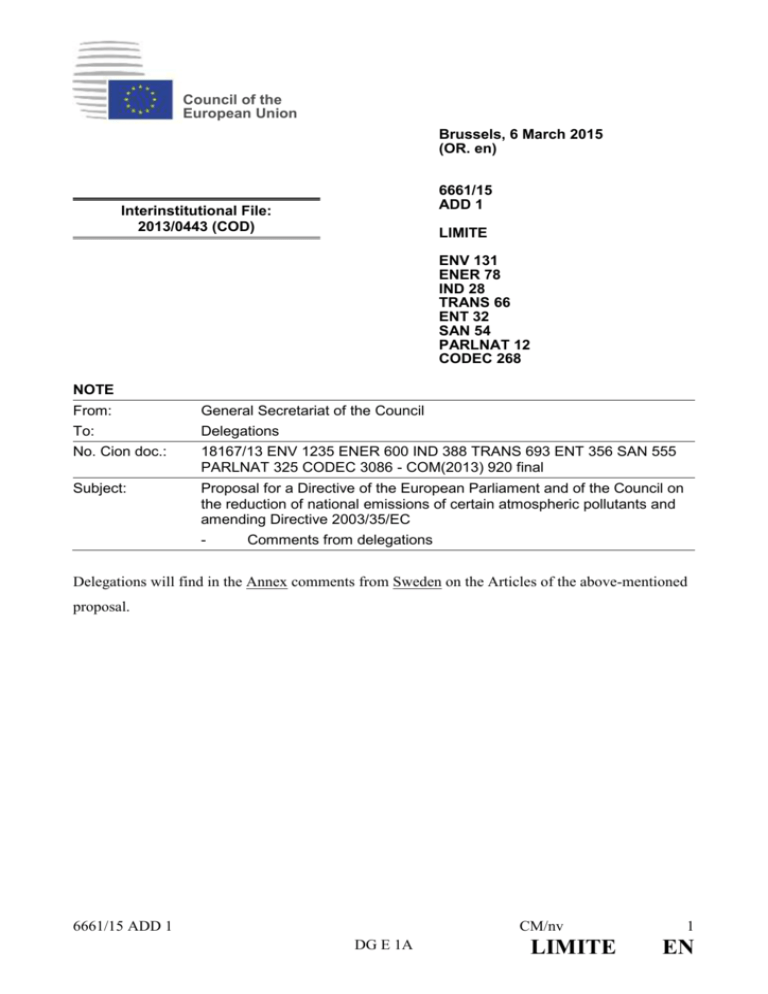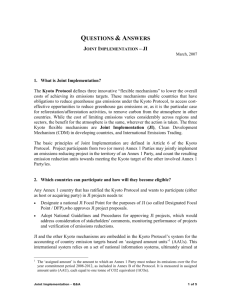limite en
advertisement

Council of the European Union Brussels, 6 March 2015 (OR. en) 6661/15 ADD 1 Interinstitutional File: 2013/0443 (COD) LIMITE ENV 131 ENER 78 IND 28 TRANS 66 ENT 32 SAN 54 PARLNAT 12 CODEC 268 NOTE From: To: General Secretariat of the Council Delegations No. Cion doc.: 18167/13 ENV 1235 ENER 600 IND 388 TRANS 693 ENT 356 SAN 555 PARLNAT 325 CODEC 3086 - COM(2013) 920 final Subject: Proposal for a Directive of the European Parliament and of the Council on the reduction of national emissions of certain atmospheric pollutants and amending Directive 2003/35/EC - Comments from delegations Delegations will find in the Annex comments from Sweden on the Articles of the above-mentioned proposal. 6661/15 ADD 1 CM/nv DG E 1A LIMITE 1 EN ANNEX SWEDEN Air pollution within EU is causing several thousand deaths annually and has large other negative effects on both health and environment. Recent studies have amplified the Commission´s findings that lowering the European emission ceilings largely in line with the original proposal would lead to substantial economic net benefits for Europe. It is only with a joint effort we can mitigate these pollutants which have detrimental effects both locally and across borders. The proposed NEC directive would, fully implemented, significantly improve todays situation and get us closer to the long-term objectives ("no significant negative impacts on health and the environment") set out in 7th EAP. Sweden warmly welcomes a revitalization of the negotiations. There is, however, still a need for some improvements of the current proposal. In the text below we focus on the issues in articles 4 to 9, with corresponding annexes, that were discussed at WPE NECD on 19 February. We are still reviewing the proposed delegated acts and will send comments on these at a later stage. Article 4 Ceiling for methane As a short-lived climate pollutant as well as an important precursor for ground-level ozone it is an important signal to include methane in the air pollution mitigation strategy. Reducing emissions of ozone precursors in order to protect the environment and human health against ground level ozone is an important objective of the NEC Directive. Today there is no legislation which directly limits emissions of methane in the EU. Methane is covered by the Kyoto protocol as one of six greenhouse gases, but MS has no obligation to reduce or limit methane emissions specifically. Sweden therefore supports the proposal of including a ceiling for methane in the NEC Directive. Linear trajectory and interim target for 2025 Sweden is in favor of aiming for a linear trajectory of emission reductions as well as for an interim target for 2025. Keeping record of and maintaining a linear trajectory of emission reductions between 2020 and 2030 is important to make sure that Member States are on the right track. This would ensure that mitigation measures are in place in good time before 2030, which is essential if the commitments are to be reached. The linear trajectory should be determined by the emission ceiling levels in 2020 and 2030 and not by the actual development of national emission. Sweden supports that this is a soft requirement. It is nevertheless important that there are requirements that ensure that Member States, in case of risk of the 2030-target not being reached, clearly can explain how, by means of actions and measures, those target will be met. This in order to safe guard the fulfillment of the 2030-targets. 6661/15 ADD 1 ANNEX CM/nv DG E 1A LIMITE 2 EN Article 5 Flexibility Sweden accepts flexibilities following the revised Gothenburg protocol (relative ceilings and adjustment mechanism) even though relative ceilings would be sufficient flexibility in itself. The adjustment mechanism for emission inventories will in our view add additional administrative burden on Member States as well as on the Commission. Those resources should preferably be used on mitigation measures. Regarding the possibility to offset emission reductions achieved by international maritime traffic we are cautiously positive but there are numbers of issues that needs to be clarified. For example, it is not clear how MS would demonstrate and control that the offset only applies to new and/or additional measures. The treatment of existing and already planned SECAs and NECAs needs to be clarified. If already implemented measures would be accounted for there is a risk that the actual emission reductions would be smaller than without this flexibility and hence we would miss the environmental benefits intended. Furthermore, Sweden is negative towards any extra flexibility such as the so called “pollutant swapping” that was presented in September 2014 (report TSAP#15). The pollutant swapping would increase administrative burden as well obscure the possibility to evaluate commitments as well as health and environmental effects in a transparent fashion. Article 6 National Air Pollution Control Programme Sweden supports the Commission´s proposal for so called National air pollution control programmes. This is an important component to ensure implementation of the directive. We also support to have a biannual update of these national programmes. Since the update to a large extent depend on the update of national projections Sweden notes that the cycle of updates for national programmes and national projections should be synchronised in time. Article 6, para 2 (b) contains a reference to “air quality objectives”. To us, it is not clear what objectives (short or long term objectives, Environmental Quality Standards or others) that are intended with this reference. We would therefore find it useful to specify which objectives the paragraph refers to or at least get an explanation from the Commission on the choice of wording in this respect. Annex III part 1 An important principle of the NEC Directive is that it is incumbent on Member States themselves to decide how to attain the emission ceilings. Of course, all relevant sectors should be included to achieve the emission ceilings in the most cost-efficient way. Since the conditions for achieving the goals differ between Member States measures should be taken on national level. This is essential in order to allow Member States to deploy the most cost-effective measures across sectors. Therefore it must be clear in the text that it is not mandatory to use the emission reductions in part 1 of Annex III. 6661/15 ADD 1 ANNEX CM/nv DG E 1A LIMITE 3 EN Annex III part 2 It is both time consuming and technically difficult to evaluate impacts of different policies and measures on emission reductions and environmental effects and their associated uncertainties. Sweden would prefer that the information under subpara “b” would be included in the national programmes only where available, which would provide for the following amendment. b) the policy options considered to meet the emission reduction commitments for 2020 and 2030 onwards and the intermediate emission levels determined for 2025 and to contribute to further improve the air quality, and their analysis, including the method of analysis; where available, the individual or combined impacts of the policies and measures on emission reductions, air quality and environment; and the associated uncertainties; Article 7-9 Reporting – emission inventories and projections Sweden supports the idea of correlating reporting obligations in the new NEC Directive with reporting obligations for climate as well as CLRTAP as far as possible. We support a biannual update of projected emissions but would prefer a longer cycle of 4 years for update of spatially disaggregated emissions and large point source inventories. A more frequent reporting of projections is motivated since the projections are a crucial input for national mitigation strategies as well as evaluation and conditions for underlying assumptions may change quite significantly between years. Sweden would like to see that the projections are further coordinated with the present biannual climate projections where “Those projections shall include quantitative estimates for a sequence of four future years ending with 0 or 5 immediately following the reporting year.” Sweden sees no need in calculating projections every year between year x and 2030. However, we would like to ask the Commission for the purpose of reporting preliminary emission data. We would also like to know what level of quality this preliminary data should have, in relation to preliminary reporting of greenhouse gases in the UNFCCC. Sweden supports most of the requirements for preparing and reporting on emission inventories and projections set out in Annex IV. However, part I, point 3 requires that Member States report emissions that are consistent with energy balances reported to Eurostat. Sweden is of the view that it will be difficult to fulfill this requirement. We therefore propose to either delete this requirement from the annex, or to reformulate it as follows: “For emissions from transport, Member States should calculate and report emissions as consistent as possible with national energy balances reported to Eurostat.” 6661/15 ADD 1 ANNEX CM/nv DG E 1A LIMITE 4 EN Monitoring – Annex V Sweden also supports the bulk of monitoring requirements set out in Annex V. Though, it is not clear either in the proposed text or in the Impact Assessment on what grounds these specific monitoring requirements, out of the more exhaustive list in the LRTAP convention, were selected for inclusion in the directive. Sweden would therefore like to get an explanation from the Commission about this. It is important that even though the annex refers to sites this does not call for measurements in all situations, but that the use of modelled estimates also would be a possibility. This is especially important where emission levels are low which may result in larger uncertainty and where measurements would not be motivated from an economic point of view. 6661/15 ADD 1 ANNEX CM/nv DG E 1A LIMITE 5 EN







